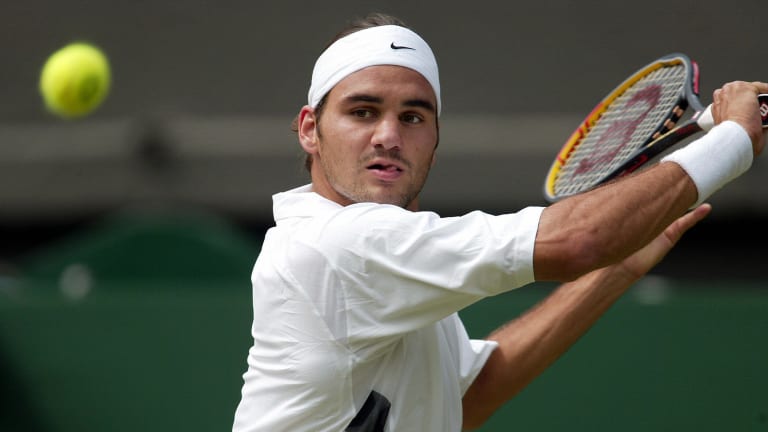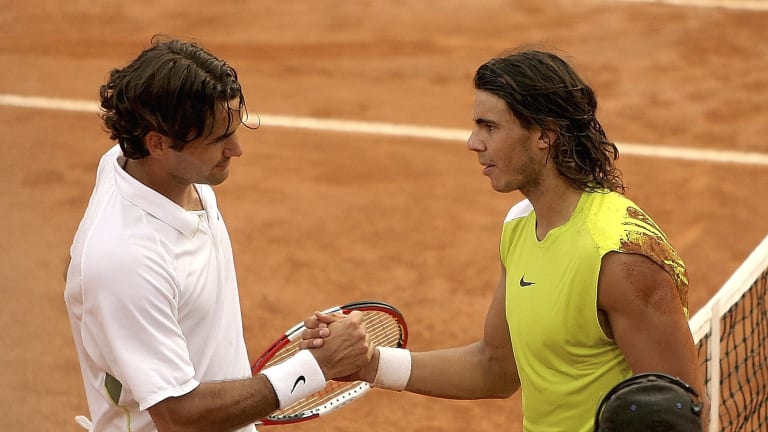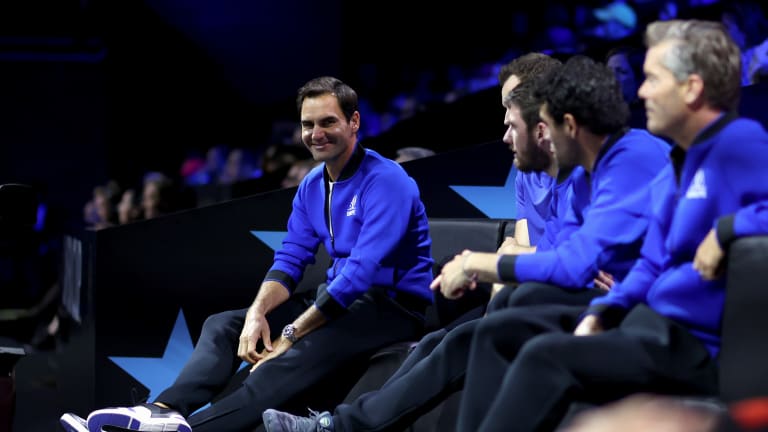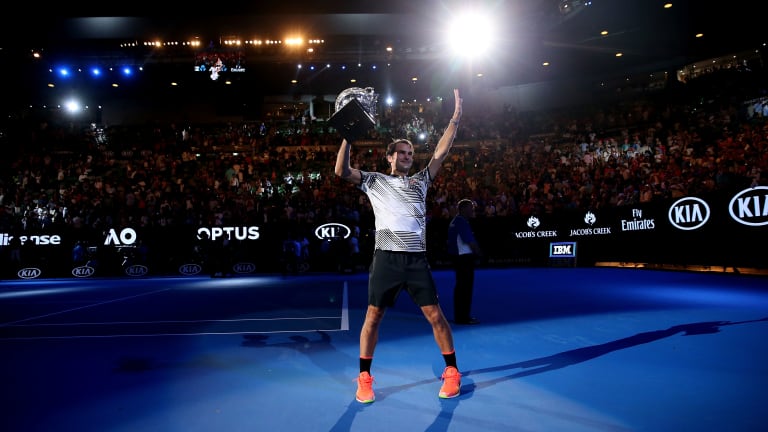Few athletes have changed their sport for the better in as many ways as Roger Federer
By Steve Tignor Sep 27, 2022Roger Federer rules out coaching role for now as retirement begins
By Kamakshi Tandon Nov 21, 2022Missing Roger Federer
By Peter Bodo Oct 03, 2022Novak Djokovic: “One of the most beautiful moments I’ve ever experienced in my life”
By John Berkok Sep 26, 2022Rafael Nadal’s tears revealed human side of Roger Federer rivalry: ‘An important part of my life is leaving too’
By Stephanie Livaudais Sep 24, 2022Alcaraz, Swiatek among tennis stars tweeting tributes during Roger Federer’s last match
By John Berkok Sep 24, 2022Roger Federer’s Laver Cup sendoff represented everything that made his career one-of-a-kind
By Steve Tignor Sep 24, 2022#tbt: Roger Federer, Rafael Nadal team up for first doubles pairing at 2017 Laver Cup
By David Kane Sep 22, 2022“The game is bright”: Roger Federer hails “new superstar” Carlos Alcaraz
By Stephanie Livaudais Sep 21, 2022Through the years: Roger and Mirka Federer
By Matt Fitzgerald Sep 21, 2022Few athletes have changed their sport for the better in as many ways as Roger Federer
He has been with us for so long, some might not appreciate how much the pro game evolved during his two-decade tenure.
Published Sep 27, 2022
Advertising
WATCH: Roger Federer's Sunday speech at the Laver Cup
“Just look at him down there. Look at that.” Those were the final nine words of the many thousands that made up David Foster Wallace’s celebrated 2006 essay “Federer as Religious Experience.” After expounding on the athletic genius and philosophical significance of the young man already known as the Maestro, the late novelist chose to conclude with the simplest of sports-fan appeals:
Watch Federer play.
Watch him, Wallace might have said, rise up on his right toe like a ballet dancer and sweep through the long arc of his one-handed backhand. Watch him pounce on a forehand and follow it forward in one seamless motion. Watch him begin his serve so easily and finish it so explosively. Watch him stick a volley with the stillest of racquet heads. Watch Federer blend grace and purpose, aesthetics and achievement.
Over the past quarter century, from his ATP debut in 1998 to his final bow at his own event, the Laver Cup, in 2022, most of us watched Federer every chance we could. While he may not be crowned the game’s GOAT, Federer should be remembered for something just as important: Few players have changed tennis for the better in so many ways.
He made the game more appealing to watch. He made the men’s tour a friendlier place to play. He brought a new emotional openness, in victory and defeat. He helped raise his colleagues’ pay. He drew in millions of news fans. And he showed that a champion’s reign doesn’t have to end at 30, or even 35.
Federer has been with us for so long, some might not appreciate how much the pro game evolved during his two-decade tenure. In that time, he helped kick off a 21st-century golden age, and lift the ceiling on what we thought was possible in tennis.
Advertising

Federer's game was art, but it wasn’t just for art’s sake anymore.
© AFP via Getty Images
Playing the Beautiful Game
“I thought tennis was boring then, all about the serve, and here’s this guy who’s making it artful again,” says longtime Federer fan Caroline Potter, thinking back to her first sightings of the Swiss in the early 2000s.
Those words sum up why a lot of Fed fans became Fed fans: He saved them from a future of serve wars and power play, which is where men’s tennis seemed to be heading at the turn of the century. One missile thrower, Pete Sampras, was leaving the stage, while the next, Andy Roddick, was making his entrance. At Wimbledon in 2003, the 20-year-old American, who had won at Queen’s Club the week before, appeared ready to grab the baton from Sampras. Federer had also won a Wimbledon tune-up tournament, in Halle, but Roddick’s sonic serve, rather than Federer’s old-fashioned finesse, looked like the future.
The collision between them came in the semifinals, and the verdict was swift. In a straight-set win, Federer made permanent converts of the Wimbledon crowd with his stylish command of Centre Court. With 17 aces, he held his own with Roddick’s serve, and he was better when the rallies began. A shoe-top backhand for a winner brought gasps from the audience and a wry smile from Roddick.
Two days later, Federer dismantled Mark Philippoussis with the same varied arsenal for the title. By beating the game’s two biggest servers on grass, Federer showed that tennis’ future wasn’t going to be one long rock fight after all. His game was art, but it wasn’t just for art’s sake anymore.
“He had all the components, and an ability to manage them,” Jim Courier says of Federer. “Tennis classicists could maintain a connection with him, because the genesis of the sport seemed to be flowing through his game.”
Not everyone would, or could, play like Federer. But he claimed space for touch, slice, net play, the one-handed backhand and a proactive tactical sense. Tennis didn’t need to be divided into power hitters and baseline grinders; you could combine the best of both styles. Today we can see his legacy in the exciting brand of all-court tennis on display each week. That includes new No. 1 Carlos Alcaraz. The Spaniard hails from the same country as Rafael Nadal, but he claims Federer as a model. You can see it in every topspin forehand drive, and delicate drop shot, that he makes.
Advertising

Federerknew there was room for both of these two very different people at the top. Tennis only became stronger because of it.
© Getty Images
Making Room at the Top
For much of the 1980s and ’90s, fans longed for the return of the bad boy era, those wild west days when John McEnroe and Jimmy Connors screamed and spat their way to stardom. Hostility was what the people wanted, right? That was still the prevailing view when Federer began his first serious rivalry, with Nadal. In the early going, Roger and Rafa seemed ready to play along.
By the time they first met, in Miami in 2004, losing was rarely in the script for Federer anymore. He was No. 1, and in the middle of a three-major-title season. But that didn’t faze the 17-year-old Nadal, who Vamos-ed his way to a 6-3, 6-3 win. Federer could see there was something different, and difficult, about the “high bounce” the young lefty produced.
“That’s a struggle I had today,” Federer said. “I tried to get out of it, but I couldn’t.”
For two years, Federer mostly failed to find a way out of the Nadal trap. By the time they met in the Rome final in 2006, the Spaniard led their head to head 4-1. Federer maintained that he was getting a “step closer” with each match, but admitted he still had to “change it next time” and be more aggressive. Federer lived up to that vow in their five-hour, five-set Rome epic. He controlled the rallies. He came to net 84 times. He led 4-1 in the fifth, 5-3 in the fifth-set tiebreaker, and had two match points. Yet he still let Nadal run away with the last four points and the title.
Up to this point, Federer and Nadal had been respectful of each other. In Rome, Federer let his frustration show. The handshake was as hurried and icy as the match was long and hot. Afterward, Federer called Nadal’s game “one-dimensional” and said he caught his uncle Toni “coaching a little but too much again today.” The next day, Rafa fired back: “He has to learn to be a gentleman even when he loses,” he said of Federer.
Were they going to repeat the feuds of tennis’ past? “It wouldn’t hurt the TV ratings or buzz factor if there was a bit of animosity,” the AP opined that spring.
Later that month, Federer and Nadal couldn’t avoid each other at the Laureus Sports Awards in Barcelona. Federer was nominated for “Sportsman of the Year,” Nadal for “Newcomer of the Year.” Each won, and each applauded for the other. More important, that moment started their rivalry, and the men’s game, down a new, more peaceful track.
“We sat at the same table with the Princess of Spain between us,” Federer said, “and we noticed that it wasn’t such a big deal.”
Nadal always knew how good Federer was; now, after Rome, Federer knew Nadal wasn’t going anywhere. He also knew there was room for both of these two very different people at the top. Tennis only became stronger because of it.
Advertising

Laver Cup was an instant success, and a testament to Federer’s stature with fans and fellow players.
© Getty Images for Laver Cup
Leading Away from the Court
Before Federer, being No. 1 and winning the ATP’s Sportsmanship Award hardly went hand in hand. McEnroe, Connors, Borg, Sampras, Lendl, Agassi, Hewitt: None claimed the honor. By contrast, since 2004, Federer has won that award, which is voted on by the players, 13 times. Perhaps more important is how Federer used his popularity.
When he joined the tour’s Player Council in 2008, he was voted president, a position he held until 2014. It was an eventful period. During a semi-disastrous, rain-soaked 2011 US Open, long-simmering complaints about scheduling, safety and prize money broke into the open. Federer responded by marshaling the influence that he and his fellow Big Four members—Nadal, Novak Djokovic and Andy Murray—had gained over the previous half-decade.
Together, they helped negotiate significant prize-money increases, from the first round to the final, at the Grand Slams. They pushed the US Open to build a roof over Arthur Ashe Stadium, and switch to a fairer schedule. In 2013, Federer commented that he was being drug tested less often than in the past, and called for a bio-passport testing and storage system. The ITF introduced it soon after.
“I think we were able to calm things down a little bit, because things were quite hectic when I came onto the Council,” said the congenitally diplomatic Swiss. “The stability has been very important for the tournaments, for the players, for the Council, for the Board. It’s just been nicer to work this way.”
Since 2014, Federer has continued to use his status for tennis’ greater good. He has teamed with Bill Gates to stage six “Matches for Africa,” which raised millions of dollars. He started a new agency, Team 8, that represents Coco Gauff, among others. He toured South America to overflow crowds with Juan Martin del Potro, and played Alexander Zverev before a record crowd of 42,000 in a Mexico City bullring.
Finally, there’s Laver Cup. For years, people around tennis asked why the sport couldn’t stage its own version of golf’s Ryder Cup. Starting in 2017, Federer and his agent, Tony Godsick, made it happen. Laver Cup did the seemingly impossible: it brought the ATP’s diverse cast of A-listers together for an untested event, and showcased their personalities in fan-friendly format. It was an instant success, and a testament to Federer’s stature with fans and fellow players.
“His affinity for the upbeat could have led him astray by encouraging him to dodge the thornier aspects of being a pro,” says Christopher Clarey, author of The Master: The Brilliant Career of Roger Federer. “Instead, he tackled it all and learned to find enjoyment in the domains that might not have been his natural habitats.
“Federer wanted to be fluent in all aspects of the game, and in the process I think he came to enjoy the game even more.”
Advertising

Federer shattered the age ceiling for male tennis champions. He showed his peers that they could keep winning, and improving, well into their 30s.
© 2017 Getty Images
Keeping Father Time at Bay
The rally began the way so many between Federer and Nadal had begun over the previous 13 years. Rafa sent a high-kicking forehand to Roger’s backhand. This time, though, instead of backing up, Federer countered by pushing Nadal behind the baseline with a looping backhand of his own. Then he moved forward, took the next backhand on the rise, and sent it crosscourt for a blazing, match-changing, and ultimately career-revivifying winner.
“I told myself to play free,” Federer said. “Be free in your head, be free in your shots, go for it. The brave will be rewarded here.”
Federer was rewarded with a break of serve in the fifth set, and, four games later, with his long-awaited 18th Grand Slam title, at the 2017 Australian Open. He was 35, returning from knee surgery, hadn’t won a major in five years, and hadn’t beaten Nadal at a Slam in 10. But instead of caving to Father Time, Federer had used his time off to develop a new, more assertive backhand. It would help take him to three more wins over Nadal, a Wimbledon title, and a 51-4 record in 2017. The following season, he would become the oldest male Grand Slam champion of the Open era, and the oldest ATP No. 1.
“He shattered any concerns we had, and totally reset the bar on what might lie ahead for him,” Darren Cahill said of that Australian Open run.
Federer also shattered the age ceiling for male tennis champions. He showed his peers that they could keep winning, and improving, well into their 30s. Before Federer, we were lucky to see our favorite players in peak form for 10 years. After Federer—and his fellow recent retiree, Serena Williams—two-decade careers may be the norm.
In his 20s, Federer’s achievements were the result of what a unique athlete, and a unique athlete alone, can do. In his 30s, his story became more universal. We could all relate to an aging champion, and we could all learn from one who turns that process on its head and unearths new elements of his talent he may not have known existed. Rather than a story of inevitable decline, Federer’s later years were about the possibilities that can come with getting older.
Yet even Federer, at 41, after three surgery-filled years, had to wave the white flag in 2022. From now on, we’ll see him in full flight only on highlights; fortunately, he has given us 20 years’ worth of “vintage Federer” clips to choose from. So I’ll finish by repeating David Foster Wallace’s advice: “Just look at him down there. Look at that.”
Federer, like the rest of us, will grow old. But the way he played the game never will.